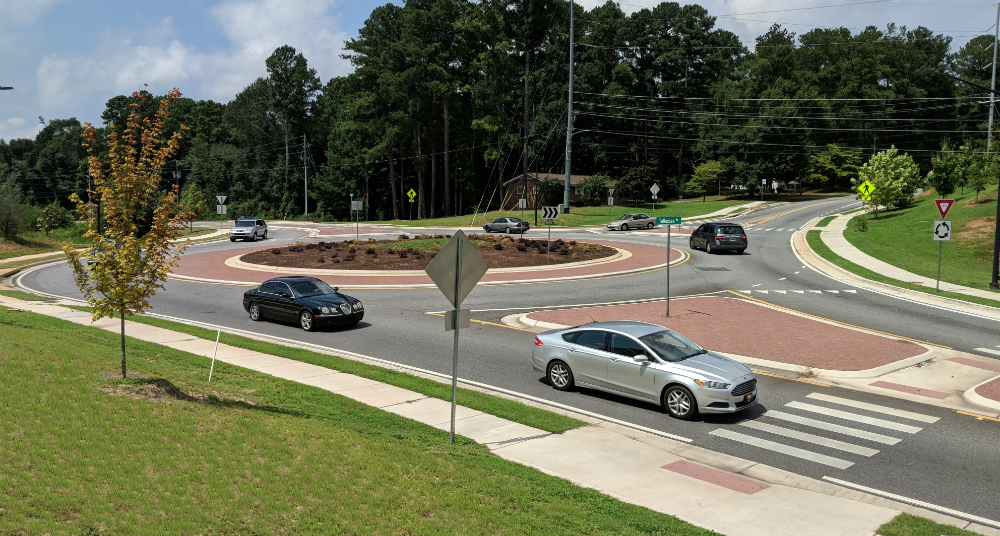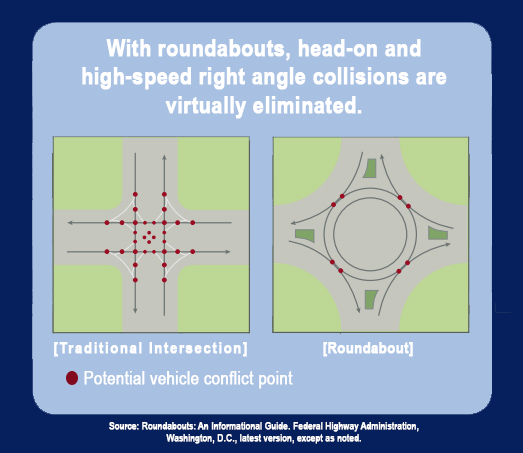
What is a Roundabout?
Roundabouts are a type of circular intersection in which entering traffic yields to vehicles already on the circulatory roadway. Roundabouts have geometric features providing a slow-speed environment that offers substantial safety advantages and excellent operational efficiency. A modern roundabout is defined by counterclockwise traffic circulation where there is no need to change lanes to exit. These junctions can have more than one lane, but the lane is chosen before reaching the entrance of the circle, and incoming traffic is required to yield to the vehicles traveling within the circle.

The History of Roundabouts
Roundabouts have been around for over 100 years, but only since the 1990s have they become popular in the U.S. Ten years ago, roundabouts and traffic circles were something rarely encountered in the southeast, with only a dozen or so existing in Georgia. In 2010, however, the Georgia Department of Transportation (GDOT) enacted a policy change requiring roundabout feasibility studies for all intersections in the state.
This transition toward increasing roundabouts picked up momentum around 2013 when roundabouts appeared on more than 160 local roads and over 40 state highway intersection traffic controls. GDOT’s move towards roundabouts was driven by the potential to solve safety and capacity problems.
With the influx of these traffic junctions occurring all around the U.S., extensive research and educational resources have been developed by the Federal Highway Administration (FHWA) and GDOT to help communities become familiar with the operational procedures of using roundabouts and the positive attributes they can provide.
Health & Safety Benefits
Research shows roundabouts are safer than traditional intersections. Where roundabouts have been installed to replace existing intersections, accidents of all types have been reduced by more than 35% and injury accidents have been reduced by more than 60%, according to statistics compiled by GDOT.
According to the FHWA, since 2010 there has been a more than 90% reduction in fatalities and 76% reduction in injuries thanks to the reduced-speed environment of roundabouts which is due to a geometric design that naturally forces vehicles to travel at lower speeds. Lower speed is correlated with better yielding rates, reduced vehicle stopping distance, and lower risk of collision injuries and fatalities. The geometric design also creates 50% fewer pedestrian-vehicle conflict points than a comparable stop sign or signal-controlled intersection. Roundabouts also remove the risk of a driver running through a stop sign or red light, causing an angle crash, such as a T-Bone or head-on collision. These types of crashes are known to be more severe in nature. Because roundabouts require vehicles to yield and then navigate around a raised, circular island, the possibility of an angle crash is significantly reduced. Roundabouts are also safer for pedestrians and bicyclists because of shorter crosswalks, also known as setback crossings. In addition to shorter pedestrian pathways, entering and exiting traffic flows are separated and traffic flow is reduced to one-directional traffic, which also makes for a safer pathway.

Operational Efficiencies
Both the FHWA and GDOT promote modern roundabouts as a safe and innovative solution to relieving highway congestion during peak hours and reducing overall delays. The operational efficiencies of roundabouts also help reduce pollution and fuel use because of fewer stops and hard accelerations and less idling time.
Cost Savings
Communities save money installing roundabouts because they typically do not require signal equipment to be installed, which is not only expensive but also requires ongoing power and maintenance. Smaller roundabouts often require less right-of-way and less pavement than traditional intersections. It is estimated that a traffic signal can cost $250K- $500K to purchase and install with annual power and maintenance costs averaging $8,000 per year, and they are routinely replaced every ten years or so. In comparison, roundabouts are significantly more efficient, costing around $194K-$500K, depending on size, and require little to no maintenance or electricity to operate.
Community Enhancements
Roundabouts also give communities the opportunity to develop additional greenspaces or gateway enhancements through landscaping, which can be aesthetically pleasing and complement other community values. They are also known to be quieter than traditional intersections.
Navigation Tips and Resources
Navigating a roundabout is easy, but people can be apprehensive about new things, so the FHWA has created many resources and guidelines to educate the public. Here are a few simple guidelines to remember when driving through a roundabout:
- Slow down when approaching a roundabout. When approaching a multi-lane roundabout, choose your lane before entering the circle. Do not switch lanes within the traffic circle.
- Always look to your left when approaching a roundabout. Check for vehicles traveling in the circle—they have the right-of-way.
- Do not stop or yield while traveling within the circle.
- Always assume trucks need all available space—don’t pass them!
- Always clear the roundabout to allow for emergency vehicles to pass when necessary.
Roundabouts are not a one-size-fits-all solution and are not recommended for every situation. In some cases, more traditional signalized or stop control intersections can be the right fix. No matter the intersection, W&A Engineering’s experienced traffic and transportation engineers can evaluate your next intersection improvement project and provide a custom fit solution for your community. We look forward to serving your community with safe, innovative, and effective transportation solutions.
Sources
- US DOT- Federal Highway Administration Roundabouts and Mini Roundabouts: https://safety.fhwa.dot.gov/intersection/innovative/roundabouts/
- GDOT Roundabouts: http://www.dot.ga.gov/DriveSmart/SafetyOperation/Pages/Roundabouts.aspx
- US DOT FHWA- Safety Aspects of Roundabouts: https://safety.fhwa.dot.gov/intersection/innovative/roundabouts/presentations/safety_aspects/long.pdf
- US DOT FHWA Roundabouts- A Safer Choice Brochure: https://safety.fhwa.dot.gov/intersection/innovative/roundabouts/fhwasa08006/fhwasa08006.pdf
- US DOT FHWA Roundabouts: w/ Pedestrians & Bicycles Brochure https://safety.fhwa.dot.gov/intersection/innovative/roundabouts/ped_bike_brochure/pedbikeroundabout.pdf
- US DOT FHWA Roundabouts & Rural Highways Brochure: https://safety.fhwa.dot.gov/intersection/innovative/roundabouts/rural_roundabouts/ruralroundabouts.pdf
- GDOT Roundabout Design Manual:http://www.dot.ga.gov/PartnerSmart/DesignManuals/DesignPolicy/GDOT-DPM.pdf
